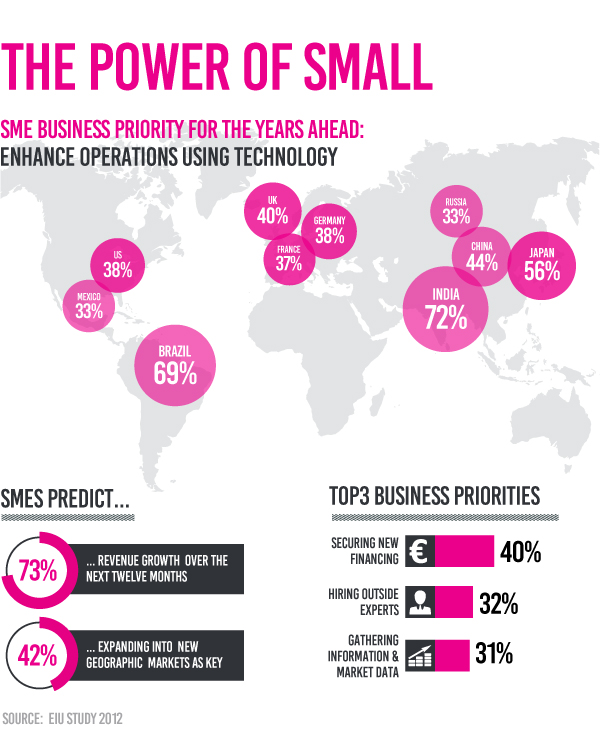![]() 5 minute read
5 minute read
Undoubtfully, new technologies will be changing the realm of working life. The labor market disruption is coming fast and media is spreading the panic. The last employment crisis in 2008 has reshaped the structure of employment. This article is looking into the future of business structure, possible new regulations, and positive sides brought by technology.
Business
demographics
Global Economic Crisis has illustrated the risks of large enterprises accounting for a sizable portion of the economical output. Another example of fatal consequences of putting all eggs in one basket is the crucial role of Nokia in Finnish economy. Large enterprises are known to be pro-cyclical, more affected by international business cycles than SMEs. In Europe, over 99% of enterprises are SME. Micro-businesses, or companies with less than 10 employees, are taking over a quarter of market structure is industries like construction, distribution trades, accommodation and food services, professional and research activities, repair business, and over the half of real estate services. According to EU statistics, people with higher education are more likely to have more than one job. With the trend of more population getting a higher education, it is not a mistake to assume that in the future people will be occupying several positions at once. Hence, it could be the establishment of several own micro or medium businesses.
Today, the size of investment in automation in the US has a potential to stimulate up to $8 trillion in incremental investments. According to some estimations, by 2030 automation would eliminate as much as 25% of current jobs. Nevertheless, as middle-class and low-wage workers would be ones under pressure, they will have to reinvent themselves using the skills to enhance operational processes. Large companies are mostly responsible for the shift. The examples are already seen today. There is evidence of companies making cuts, like Siemens letting go of almost 7,000 employees to consolidate power generation unit, or Barnes [&] Noble coming up with a new labor model that requires fewer humans. Therefore, government investments in creating small and medium enterprises are crucial to ensure the workforce balance in the future.
AI creates a
shortcut for success
According to Adecco research, companies with over 5,000 staff are twice as skeptical about the business impact of AI compared to those employing 250 people or less. “Investment in technologies such as automation will help to make our economy more competitive, enable us to build on our world-leading reputation in cutting-edge sectors, and allow us to establish better ways of doing business. Smaller companies seem to realize this and as a result, have a huge opportunity to benefit,” says Alex Fleming from Adecco Group. Moreover, many advocates believe that lean and more flexible SMEs will gain a competitive edge with fast adoption of new technologies like AI, VR, and AR.
Having the technology that automates business processes like customer service and data-analysis, anyone with a basic business knowledge can become a CEO with the powerful information in hands without the need of hiring departments with a variety of skills. AI creates a shortcut for success. The customer’s service can be performed by digital bots, the website created within a day, and social media channels promotion is becoming user-friendlier day-by-day. At the same time, governments invest in the entrepreneurship aiming to distribute the market power and create a flexible economy that can operate under various international cycles.

Gig-economy
and legislation
According to McKinsey estimations, the quarter of the workforce in the US and the EU-25 consists of self-employed and temporary workers, – 162 million people. From those who chose to become an independent worker, 49 million use gig-economy as a primary income, while for 64 million it is additional earnings. At the same time, 49 million people engage in the self-employment by necessity, half of which would rather prefer a traditional job. Independent work is rapidly evolving with new freelance opportunities enabled by various digital platforms and reduction of distance. Thus, there is an increasing number of people finding job on-demand.
With a rise of gig-economy, the lack of legislation came to attention. As many platforms are using zero-hour based contracts, workers are at risk of having no sick leaves or vacations. “The benefit of gig work is that it gives people the flexibility to boost their income, but it comes without the benefits that full-time employment provides such as holiday pay and income protection,” says Chris Atkinson, head of innovation and partnerships at Zurich UK. As a result, governments are developing new policies that would be guaranteeing new rights for independent workers repelling unpaid internships, stricter enforcement of holiday and sick pay right, making payslips a norm for freelancers, as well as increasing the minimum of the hourly wage. It is expected that zero-hour contracts would stop its existence, which would push both firms and workers to more standardized and protected cooperation.




